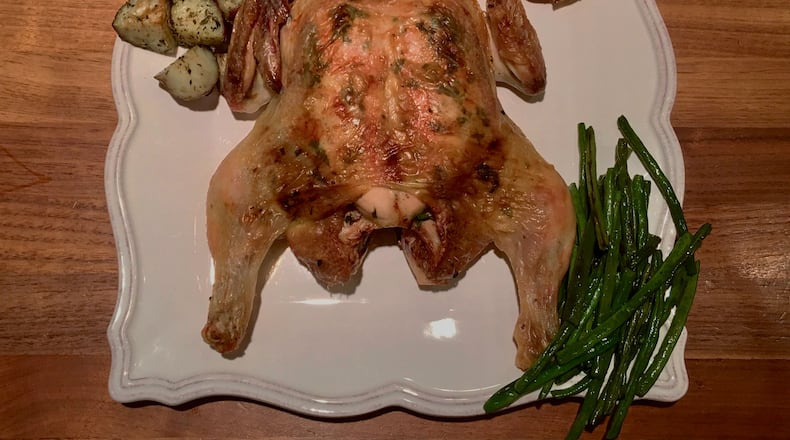I had many questions about the chicken. Not a bawk-bawk chicken, the likes of which are as ubiquitous as cold brewed coffee in my gentrified neighborhood. I mean a 3-pound whole fryer in the butcher case. Would it take an eternity to roast? Yield both dangerously rare legs and overcooked white meat? And, the most obvious question of all, why would I ever cook a bird from scratch when there is a flock of prepared rotisserie chickens roosting in the deli department?
The answer, of course, is that a rotisserie chicken can contain up to four times the sodium as a do-it-yourselfer. If the health cost doesn’t give you pause, the actual cost should: The rotisserie chicken at my market weighs in around $1-$2 more per pound than its raw relative. And when you roast the chicken yourself, you can use your family’s favorite seasonings, which has the added benefit of making your house smell amazing. It was time for me to stop being so chicken about cooking poultry. I grabbed my cooking shears, tossed the raw chicken on its back, and spatchcocked it.
Spatchcock is a funny foodie term for cutting a bird open so that it lies flat. While the name is complicated, the technique is easy. Simply slice down both sides of the backbone, from tip to tail. Remove the backbone and reserve it for homemade stock. Then flip the chicken and press the heels of your hands on top of the breast until the cartilage at the tip of the breastbone cracks, like CPR gone horribly awry. If your chicken’s cartilage is particularly sturdy, use cooking shears to make a 1/2-inch vertical cut through the cartilage and try again.
Lay the chicken flat on a wire rack or bed of onions, and place the pan in a high-heat oven. The legs at the edges of the pan will cook faster than the white meat in the middle. Like magic, both will simultaneously reach a safe and even internal temperature of 165 degrees after about 45 minutes of minimally supervised roasting time. So you can cook a Sunday-worthy supper while doing weeknight chores. Like shooing your neighbor’s chooks that have free-ranged into your flowerbeds.
The skin on a spatchcocked chicken is easy to separate from the meat. Press pinches of salt and pepper underneath the skin, or go all out with your favorite aromatics, like lemon and tarragon, rosemary and thyme, or basil with sun-dried tomatoes. My friend Jason tucks dried apricots and honey under his chicken’s skin, which might be the best use of apricots and honey that I’ve ever heard. No matter how you season your chicken, the skin will trap the flavors and infuse the meat with yumminess.
But is skin-on chicken allowed in a healthy diet? That depends on how strict you are. A serving of skin-on chicken contains an additional 50 calories and 2.5 grams of saturated fat over the naked equivalent. So you probably shouldn’t eat it every day. But if a little golden roasted chicken is your incentive for cooking at home, well, who am I to question it?
About the Author
The Latest
Featured


